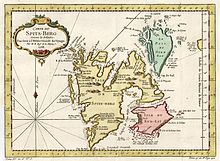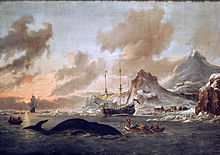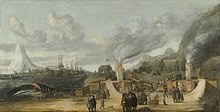History of Svalbard
The polar archipelago of Svalbard was first discovered by Willem Barentsz in 1596, although there is disputed evidence of use by Pomors or Norsemen. Whaling for bowhead whales started in 1611, dominated by English and Dutch companies, though other countries participated. At that time there was no agreement about sovereignty. Whaling stations, the largest being Smeerenburg, were built during the 17th century, but gradually whaling decreased. Hunting was carried out from the 17th century by Pomors, but from the 19th century it became more dominated by Norwegians.
Exploration was initially conducted to find new whaling grounds, but from the 18th century some scientific expeditions took place. These were initially large scale, but from the late 19th century they became smaller and increasingly focused on the interior. The most important scientific explorers were
During the
During the Golden Age of Dutch exploration and discovery (c. 1590s–1720s)
First verified discovery of Svalbard as a terra nullius


There is no conclusive evidence of the first human activity on Svalbard. Swedish archeologist Hans Christiansson found flint and slate objects he identified as
The first undisputed discovery of the archipelago was an expedition led by the Dutch mariner Willem Barentsz, who was looking for the
International whaling base

The first hunting expedition, to Bjørnøya, was organized by the
This led to an international political conflict. The Dutch rejected the English exclusive rights, claiming the mare liberum principle.

In 1614, the English and Dutch partitioned the island, as the aggression was hampering the profitability of both groups. That year, the Netherlands created Noordsche Compagnie as a whaling cartel. After the Muscovy Company fell into financial difficulties some years later, the Noordsche Compagnie got the upper hand and was able to dominate the whaling and fend off the English.[12] They established themselves in the northwestern corner of Spitsbergen (around Albert I Land) and only permitted a limited Danish presence. The English whaled further south, while the French were allocated to the north coast and the open sea. From the 1630s, the situation stabilized and there were only a limited number of aggressive incidents.[13]
Initially, all nations hired Basque whalers,[14] although they gradually disappeared after their knowledge was learned by their companions. The whaling method was based on landing the whale, where it would be partitioned and the blubber boiled. With a high concentration of whales close to land, the method was efficient, as the companies would split the crew between the land station and hunting.[15] The most famous land station was the Dutch Smeerenburg on Amsterdam Island which had up to 200 people employed. Because of the high costs involved, only larger companies conducted whaling. By the late 17th century there were between 200 and 300 ships and in excess of 10,000 whalers around Spitsbergen.[16] The first overwintering was accidentally experienced by an English group in Bellsund in 1630–31. The first planned overwintering was achieved by the Noordsche Compagnie in 1633–34.[17]

A limited amount of open-sea whaling was performed by interlopers—independent entrepreneurs. The Noordsche Compagnie was disbanded by the government in 1642. The decade also saw an increase in whaling outside the main bays and fjords.
Hunting
It is not known when Pomors first came to Svalbard, although permanent activity had been established by the mid-16th century.[21] Hunters were sent by merchants, and monasteries, such as Solovetsky Monastery, and settled in smaller stations along the coast. They would hunt reindeer, Arctic fox, seals, walrus and polar bears. The activity was most extensive at the end of the 18th century, when an estimated 100 to 150 overwintered.[22] Unlike the whaling, Pomor activity was sustainable, they alternated stations between seasons and did not deplete the natural resources.[23]

Further exploration
Exploration of the archipelago started in the 1610s as the whaling companies would send out small ships to find new areas to exploit. By 1650 it was established that Spitsbergen was an island and not connected to Greenland. Whalers gradually accumulated a good geographic knowledge of the coastline, but the interior remained uncharted.

Scientific exploration increased through the 18th century, with the most extensive surveys being carried out by
Svalbard was used as the starting point for several expeditions to reach the North Pole by air.
Industrialization
The first attempt at creating a permanent settlement was carried out by Sweden's Alfred Gabriel Nathorst. He established Kapp Thordsen on Isfjorden in 1872, but the planned phosphorite mining was not carried out and the settlement abandoned.[36] Coal had always been mined and gathered by whalers and hunters, but industrial mining did not start until 1899. Søren Zachariassen of Tromsø was the first to establish a mining company to exploit Svalbard minerals. He claimed several places in Isfjorden and exported coal to the mainland, but lack of capital stopped further growth.[37]
The first commercially viable mining company was
Jurisdiction
Although Denmark–Norway never formally gave up its claim to Svalbard, the archipelago continued to be a terra nullius—a land without a government. The work to establish an administration was initiated by Nordenskiöld in 1871, in which he established that only Russia and Norway would object to an annexation of the island.[41] Fridtjof Nansen's endeavors raised the Norwegian public's consciousness of the Arctic, which again brought forth public support for annexation of Svalbard.[42] Yet the need for jurisdiction came from the mining community. Firstly, there was no means to make a mining claim legal. Secondly, there was a need for conflict resolution, particularly regarding labor conflicts, which often saw the mining company and the workers have different nationalities.[43]

The Government of Norway took initiative in 1907 for negotiations between the involved states.
After significant political debate, a proposal to establish Svalbard as a dependency and administer it from Tromsø was rejected. Instead the Svalbard Act specified that the islands would be administered by the Governor of Svalbard and was considered "part of the Kingdom of Norway", although not regarded as a county. The islands had until then been known as the Spitsbergen Archipelago, and it was at this time the term Svalbard was introduced. The legislation took effect on 14 August 1925.[46] A mining code was passed in 1925 and by 1927 all mining claims, some of which conflicted, were resolved.[47] All unclaimed land was taken over by the Norwegian Government.[48] Although the Soviet Union was initially skeptical to the treaty, they were willing to trade a signing of it in exchange for a Norwegian recognition of the Soviet regime.[49]
During the 1920s, mining fell into an economic slump, with several of the mining communities being closed. By the 1930s, only Store Norske and the Soviet state-owned
World War II
Svalbard was initially unaffected by the
With the island evacuated, German troops occupied Longyearbyen, where they built an airstrip and a
Cold War

In 1944, the Soviet Union proposed that Svalbard become a
The political tension

Grumant was closed in 1961.[61] The following year, 21 miners were killed in an accident in Ny-Ålesund, which led to the Kings Bay Affair, ultimately resulting in the withdrawal of Gerhardsen's Third Cabinet. Oil drilling was started by Caltex in 1961. They were granted claims based on indications, rather than samples, of oil, which was not granted to Arktikugol, leading to strained relations with the Soviet Union.[60] No commercially viable wells were found. A new round of searching in the 1980s was also fruitless.[62]
Both the Kings Bay Affair and the Caltex Affair initiated public debate about the administration of Svalbard, and in particular the lack of resources and control of Soviet settlements. Funding for local and central administration was increased heavily
Normalization
"Normalization" was a term coined in the 1970s to transform Longyearbyen from a
Since the 1990s, several research and hi-tech institutes have established themselves, such as the
References
- Bibliography
- Arlov, Thor B. (1994). A short history of Svalbard. Oslo: ISBN 82-90307-55-1.
- Hisdal, Vidar (1998). Svalbard: nature and history. Oslo: ISBN 82-7666-152-1.
- Holm, Kari (1999). Longyearbyen – Svalbard: historisk veiviser (in Norwegian). ISBN 82-992142-4-6.
- Carlheim-Gyllensköld, V. (1900). På åttionda breddgraden. En bok om den svensk-ryska gradmätningen på Spetsbergen; den förberedande expeitionen sommaren 1898, dess färd rundt spetsbergens kuster, äfventyr i båtar och på isen; ryssars och skandinavers forna färder; m.m., m.m. Stockholm: Albert Bonniers förlag.
- Notes
- ^ Christiansson, Hans; Povl Simonsen (1970). Stone Age Finds from Spitsbergen. Acta Borealia, v. 11. Universitetsforlaget. Retrieved 18 Dec 2012.
- ^ Arlov (1994): 12
- S2CID 131600382.
- ^ "A History of Svalbard". World History Encyclopedia. Retrieved 2022-01-30.
- ^ Arlov (1994): 13
- ^ Arlov (1994): 14
- ^ a b Arlov (1994): 9
- ^ Arlov (1994): 10
- ^ Arlov (1994): 11
- ^ Arlov (1994): 16
- ^ Arlov (1994): 18
- ^ a b Arlov (1994): 19
- ^ Arlov (1994): 20
- ^ Arlov (1994): 23
- ^ Arlov (1994): 24
- ^ Arlov (1994): 25
- ^ Arlov (1994):35
- ^ Arlov (1994): 27
- ^ Arlov (1994): 31
- ^ Arlov (1994): 32
- ^ Arlov (1994): 36
- ^ Arlov (1994): 37
- ^ Arlov (1994): 38
- ^ Arlov (1994): 34
- ^ Carlheim-Gyllensköld (1900), p. 155
- ^ Arlov (1994): 39
- ^ Goll, Sven (19 September 2008). "Arctic mystery resolved after 135 years". Aftenposten. Archived from the original on 29 June 2011. Retrieved 29 June 2011.
- ^ Arlov (1994): 42
- ^ Arlov (1994): 43
- ^ a b Arlov (1994): 44
- ^ Arlov (1994): 45
- ^ Arlov (1994): 46
- ^ Ørvoll, Oddveig Øien. "The history of place names in the Arctic". Norwegian Polar Institute. Archived from the original on 29 April 2012. Retrieved 19 April 2012.
- ^ Arlov (1994): 48
- ^ a b Hisdal (1998): 103
- ^ a b Arlov (1994): 51
- ^ a b Arlov (1994): 52
- ^ Arlov (1994): 57
- ^ a b Arlov (1994): 56
- ^ Arlov (1994): 69
- ^ Arlov (1994): 60
- ^ Arlov (1994): 62
- ^ Arlov (1994): 63
- ^ Arlov (1994): 64
- ^ Arlov (1994): 65
- ^ Arlov (1994): 68
- ^ Arlov (1994): 70
- Norwegian Ministry of Justice and the Police. 29 October 1999. Archivedfrom the original on 11 October 2012. Retrieved 19 April 2012.
- ^ Arlov (1994): 71
- ^ Arlov (1994): 72
- ^ Arlov (1994): 73
- ^ Arlov (1994): 74
- ^ Arlov (1994): 75
- ^ Holm (1999): 53
- ^ Arlov (1994): 76
- ^ Arlov (1994): 78
- ^ a b Arlov (1994): 79
- ^ Arlov (1994): 80
- ^ Arlov (1994): 81
- ^ a b c Arlov (1994): 82
- ^ a b c Arlov (1994): 83
- ^ Arlov (1994): 84
- ^ Arlov (1994): 85
- ^ Holm (1999): 119
- ^ a b c Holm (1999): 141
- ^ Store Norske (29 January 2016). "Store Norske". Archived from the original on 29 January 2016.
- ^ Sabbatini, Mark (2 March 2020). "Svea Locked". icepeople.net. Retrieved 2 July 2023.
- ^ Arlov (1994): 86
- ^ Hisdal (1998): 116
- ^ Holm (1999): 137
- ^ Holm (1999): 125
- ^ Holm (1999): 132
- Ministry of Justice and the Police. 17 April 2009. Retrieved 24 March 2010.
- ^ Holm (1999): 36
- ^ Gjesteland, Eirik (2003). "Technical solution and implementation of the Svalbard fibre cable" (PDF). Teletronikk (3): 140–152. Archived from the original (PDF) on 15 April 2012. Retrieved 12 April 2012.
- ^ "Svalbard Global Seed Vault: Frequently Asked Questions". Government.no. Archived from the original on 25 February 2012. Retrieved 11 April 2012.
- ^ Hisdal (1998): 115
- ^ "Settlements". Governor of Svalbard. Archived from the original on 6 May 2012. Retrieved 19 April 2012.
- ^ "Environmental Act". Governor of Svalbard. Archived from the original on 29 April 2012. Retrieved 19 April 2012.
- ^ "Protected Areas in Svalbard". Norwegian Directorate for Nature Management. Archived from the original on 29 February 2012. Retrieved 4 March 2012.
- ^ "Personer i bosetningene 1. januar. Svalbard" (in Norwegian). Statistics Norway. Archived from the original on 12 October 2009. Retrieved 19 April 2012.
